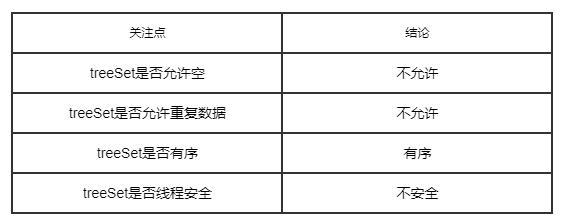一、前言
前面分析了Set接口下的hashSet和linkedHashSet,下面接着来看treeSet,treeSet的底层实现是基于treeMap的。
四个关注点在treeSet上的答案

二、treeSet的数据结构
因为treeSet的底层是基于treeMap的,所以treeSet的数据结构就是treeMap的数据结构:红黑树,因为前面已经分析过了treeMap的数据结构,这里不再赘述。集合之TreeMap(含JDK1.8源码分析)。
三、treeSet源码分析-属性及构造函数
3.1 类的继承关系
public class TreeSet<E> extends AbstractSet<E> implements NavigableSet<E>, Cloneable, java.io.Serializable
说明:实现了NavigableSet接口,定义了一些共有的操作。
3.2 类的属性
/** * The backing map. */ private transient NavigableMap<E,Object> m; // Dummy value to associate with an Object in the backing Map private static final Object PRESENT = new Object(); //版本号 private static final long serialVersionUID = -2479143000061671589L;
说明:属性m为NavigableMap接口,treeSet的一些操作都是基于此map的,而前面分析treeMap的时候,发现treeMap实现了NavigableMap接口,所以hashSet中基于NavigableMap接口的操作实际上都是基于其实现类treeMap的操作,此处也是多态的概念。
treeMap的继承实现关系:
public class TreeMap<K,V> extends AbstractMap<K,V> implements NavigableMap<K,V>, Cloneable, java.io.Serializable
而对于Object类型的属性PRESENT,在分析hashSet的时候已经做了说明,因为map(treeSet中是NavigableMap)是存储key-value键值对的,所以PRESENT只是配一下key-value中value的位置,起个占位的作用,没有什么实际的意义,所有通过treeSet添加进来的key都对应同一个value值,PRESENT。
3.3 类的构造函数

1、TreeSet(NavigableMap<E,Object> m)型
/** * Constructs a set backed by the specified navigable map. */ TreeSet(NavigableMap<E,Object> m) { this.m = m; }
说明:构建一个treeSet,基于navigable map(其实现类treeMap)实现的。
2、TreeSet()型
/** * Constructs a new, empty tree set, sorted according to the * natural ordering of its elements. All elements inserted into * the set must implement the {@link Comparable} interface. * Furthermore, all such elements must be <i>mutually * comparable</i>: {@code e1.compareTo(e2)} must not throw a * {@code ClassCastException} for any elements {@code e1} and * {@code e2} in the set. If the user attempts to add an element * to the set that violates this constraint (for example, the user * attempts to add a string element to a set whose elements are * integers), the {@code add} call will throw a * {@code ClassCastException}. */ public TreeSet() { this(new TreeMap<E,Object>()); }
说明:构建一个treeSet,排序是基于插入元素的自然顺序。
3、TreeSet(Comparator<? super E> comparator)型
/** * Constructs a new, empty tree set, sorted according to the specified * comparator. All elements inserted into the set must be <i>mutually * comparable</i> by the specified comparator: {@code comparator.compare(e1, * e2)} must not throw a {@code ClassCastException} for any elements * {@code e1} and {@code e2} in the set. If the user attempts to add * an element to the set that violates this constraint, the * {@code add} call will throw a {@code ClassCastException}. * * @param comparator the comparator that will be used to order this set. * If {@code null}, the {@linkplain Comparable natural * ordering} of the elements will be used. */ public TreeSet(Comparator<? super E> comparator) { this(new TreeMap<>(comparator)); }
说明:构建一个treeSet,排序是基于自定义的比较器的排序规则。
4、TreeSet(Collection<? extends E> c)型
/** * Constructs a new tree set containing the elements in the specified * collection, sorted according to the <i>natural ordering</i> of its * elements. All elements inserted into the set must implement the * {@link Comparable} interface. Furthermore, all such elements must be * <i>mutually comparable</i>: {@code e1.compareTo(e2)} must not throw a * {@code ClassCastException} for any elements {@code e1} and * {@code e2} in the set. * * @param c collection whose elements will comprise the new set * @throws ClassCastException if the elements in {@code c} are * not {@link Comparable}, or are not mutually comparable * @throws NullPointerException if the specified collection is null */ public TreeSet(Collection<? extends E> c) { this(); addAll(c); }
说明:构建一个treeSet,包含参数c中的元素,排序是基于元素的自然顺序。
5、TreeSet(SortedSet<E> s)型
/** * Constructs a new tree set containing the same elements and * using the same ordering as the specified sorted set. * * @param s sorted set whose elements will comprise the new set * @throws NullPointerException if the specified sorted set is null */ public TreeSet(SortedSet<E> s) { this(s.comparator()); addAll(s); }
说明:构建一个treeSet,排序是基于SortedSet指定的排序规则。
四、treeSet源码分析-核心函数
4.1 增:add函数----存储元素
/** * Adds the specified element to this set if it is not already present. * More formally, adds the specified element {@code e} to this set if * the set contains no element {@code e2} such that * <tt>(e==null ? e2==null : e.equals(e2))</tt>. * If this set already contains the element, the call leaves the set * unchanged and returns {@code false}. * * @param e element to be added to this set * @return {@code true} if this set did not already contain the specified * element * @throws ClassCastException if the specified object cannot be compared * with the elements currently in this set * @throws NullPointerException if the specified element is null * and this set uses natural ordering, or its comparator * does not permit null elements */ public boolean add(E e) { return m.put(e, PRESENT)==null; }
说明:添加一个原先set中未存在的元素,返回true,若是该元素已经存在,set不做改变,返回false。
可以看到其方法内部调用navigableMap的put方法,因为treeMap是其实现类,所以实际执行的时候,调用的是treeMap的put方法。可参见:集合之TreeMap(含JDK1.8源码分析)。
4.2 增:remove函数----删除元素
/** * Removes the specified element from this set if it is present. * More formally, removes an element {@code e} such that * <tt>(o==null ? e==null : o.equals(e))</tt>, * if this set contains such an element. Returns {@code true} if * this set contained the element (or equivalently, if this set * changed as a result of the call). (This set will not contain the * element once the call returns.) * * @param o object to be removed from this set, if present * @return {@code true} if this set contained the specified element * @throws ClassCastException if the specified object cannot be compared * with the elements currently in this set * @throws NullPointerException if the specified element is null * and this set uses natural ordering, or its comparator * does not permit null elements */ public boolean remove(Object o) { return m.remove(o)==PRESENT; }
说明:若set中存在要删除的元素,删除,返回true,不存在,返回false。
可以看到其方法内部调用navigableMap的remove方法,因为treeMap是其实现类,所以实际执行的时候,调用的是treeMap的remove方法。可参见:集合之TreeMap(含JDK1.8源码分析)。
4.3 contains函数----是否存在该元素
/** * Returns {@code true} if this set contains the specified element. * More formally, returns {@code true} if and only if this set * contains an element {@code e} such that * <tt>(o==null ? e==null : o.equals(e))</tt>. * * @param o object to be checked for containment in this set * @return {@code true} if this set contains the specified element * @throws ClassCastException if the specified object cannot be compared * with the elements currently in the set * @throws NullPointerException if the specified element is null * and this set uses natural ordering, or its comparator * does not permit null elements */ public boolean contains(Object o) { return m.containsKey(o); }
说明:若set中存在该元素,返回true,不存在,返回false。
可以看到其方法内部调用navigableMap的containsKey方法,因为treeMap是其实现类,所以实际执行的时候,调用的是treeMap的containsKey方法。
五、总结
总之,treeSet底层是基于treeMap实现的,可以自定义比较器对元素进行排序,或是使用元素的自然顺序。